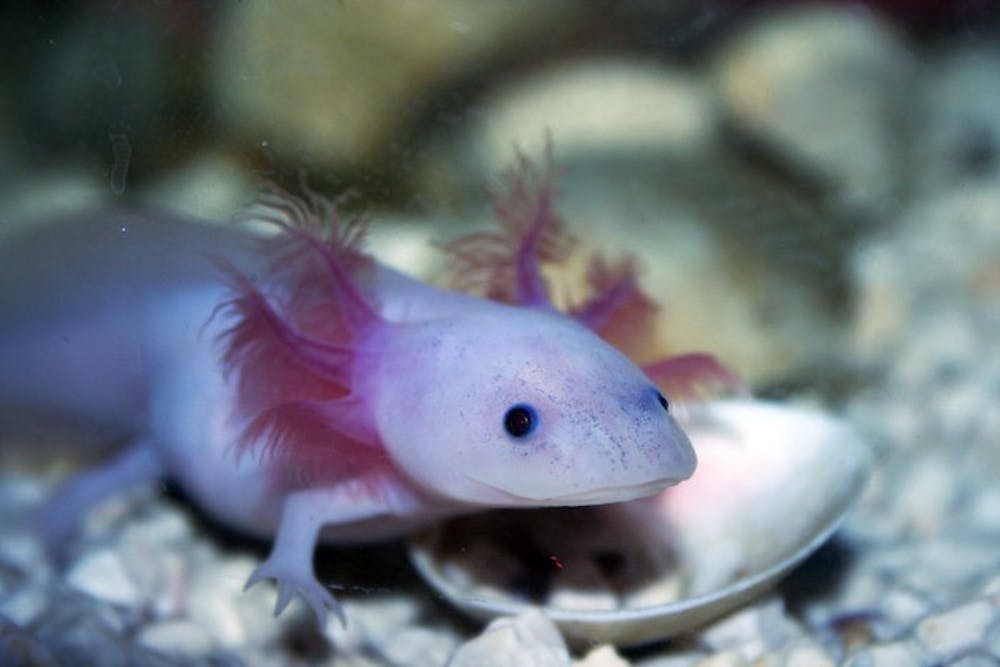Characterized by the branch-like projections from its neck and named after the Aztec god Xolotl of lightning and death, the axolotl (pronounced ACK-suh-LAH-tuhl) is probably the most scientifically studied salamander in the world, according to National Geographic.
French explorers in the middle of the 19th century captured 34 axolotls from Lake Xochimilco in Mexico. Later, a few of these animals were transferred to herpetologist Auguste Duméril who introduced them into the scientific world.
Today it would be rare to encounter axolotls in the wild, for they are critically endangered due to the draining and contamination of Lake Xochimilco. In fact, the remaining axolotl population is shrinking further because of aquarium trading and the practice of roasting axolotl as a delicacy.
In a recent article published in the journal Nature, Sergej Nowoshilow, from the Max Planck Institute of Molecular Cell Biology and Genetics in Dresden, Germany, and colleagues analyzed and sequenced the entire genome of the axolotl using a new technique called MARVEL. They reported that the axolotl has 32 million base pairs in its genome, which is 10 times more than the human genome and the largest genome ever sequenced to this date.
The axolotl is a salamander with remarkable abilities for healing wounds and regenerating limbs. It can even regenerate damaged internal organs. Unlike mammals, the axolotl uses a wound-healing mechanism that does not involve scar tissue. Its cells can revert back to stem cells and regrow the missing tissue. This extraordinary ability makes the axolotl a considerable research interest that perhaps can revolutionize medical sciences.
Elly Tanaka, a senior scientist at the Research Institute of Molecular Pathology in Vienna and senior author of this study, shares the purpose behind this study.
“We want to understand the huge changes in the RNA and proteins that the cells produce to change from an adult cell to a stem cell,” Tanaka said, according to The New York Times. “How does an injury cause such a huge change? We can’t understand that without knowing how different parts of the genome are used to change how cells behave.”
Bloomberg Distinguished Associate Professor of Computer Science and Biology Michael Schatz shares his thoughts about the short and long-term effects of sequencing the axolotl genome and how it can be translated into medical research.
“In the short term, this will lead to better understanding of the genetic and molecular mechanisms of axolotl’s amazing healing capabilities. While I don’t think people will ever be able to regrow entire limbs, longer term this could give some clues on how to develop medications to help wounds heal faster and more completely” Schatz wrote in an email to The News-Letter.
While the researchers did not find the essential Pax3 gene that plays a critical role in formation of tissue and organs during development, they found that the axolotl’s Pax7 gene has similar functions to the Pax3 gene.
The research team identified only a few genes associated with regeneration, but there is still much work to be done.
“The adventure is just starting,” Tanaka said. “Completing the genome will open up a wealth of opportunities in studying how organisms regenerate. We’re just as excited as people were when they first decoded the human genome.”
Schatz conducts research to understand the structure and functions of genomes, especially for those of medical and agricultural importance. He believes MARVEL to be an exciting, new development that has wide implications.
“I think this is an exciting development because it demonstrates how we can now map out the genomes of nearly any plant or animal, even if they have very large genomes,” Schatz wrote.
Schatz also used parts of the MARVEL assembler for his previous work to develop the FALCON assembler. The algorithm provided a more accurate picture of the wine grape Cabernet Sauvignon’s DNA, which can be used to produce tasty and flavorful grapes.
Besides contributing to the development of new wine grape variants, Schatz and his research team are mapping out the breast cancer genome more completely.
“We are also using this technology for improved analysis of human genomes — we currently have a paper under review applying this same long read sequencing technology to map out a breast cancer genome better than ever before, and we are finding tens of thousands of variants that were previously missed using older technologies,” Schatz wrote.























Please note All comments are eligible for publication in The News-Letter.